

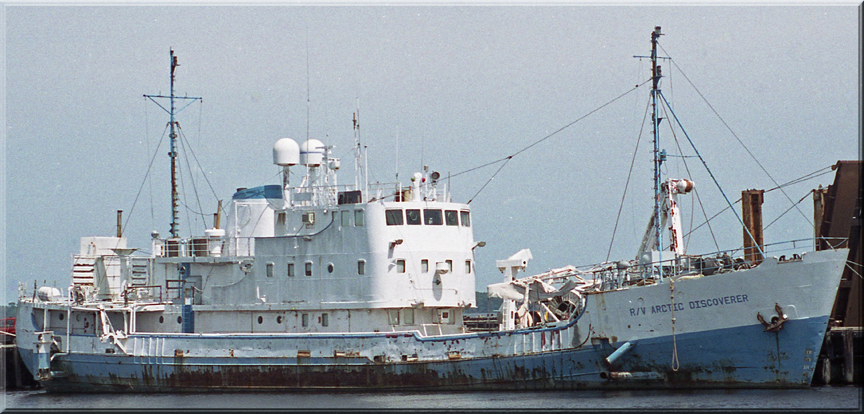
Introduction: My name is Richard (Rick) Jacquot. I am an amateur historian working to preserve the history of the R/V Arctic Discoverer, and its role in the recovery of the S.S. Central America shipwreck from 1857. I have no connection to the crew of the Arctic Discoverer or its expedition to the Central America. I am a collector of history and artifacts, and have been following this adventure since the 1980s. I have derived my information from reading the books; America's Lost Treasure, Tommy Thompson, 1998, and Ship of Gold in the Deep Blue Sea, Gary Kindler, 1998. I have read just about every magazine article and watched numerous newscasts and documentaries involving the ship. Most recently, I was fortunate to have some correspondence with Chief Scientist and Historian, Bob Evans, who has been involved in every expedition to the S.S. Central America. His first hand knowledge and information has been invaluable to this site and it is very much appreciated.
Any discrepancies or misinformation contained on this site are my fault and I can correct anything that someone believes may be inaccurate. Feel free to contact me at: RickJacquot@gmail.com or call anytime 828-779-4501.
HISTORY
The R/V Arctic Discoverer began her career in 1958 as the A.T. Cameron. The A.T. Cameron was commissioned to be built by the Fisheries Research Board in 1956. The ship was delivered in 1958 and named after Alexander Thomas Cameron, the board director. The ship was used for testing new technology/ocean research equipment, an icebreaker, and fishing.
She operated for 23 years before being decommissioned as ships with newer technology were being put into use. The A.T. Cameron was labeled as 81-4 in 1981. Not long afterwards, the ship was sold to a fuel company in Newfoundland and used as a research and patrol vessel and renamed again, the Arctic Ranger.
|
The A.T. Cameron, a Canadian Fishing Research Vessel and Icebreaker
Photo courtesy of
Captain Jouke Haanstra |
The A.T. Cameron, a Canadian Fishing Research Vessel and Icebreaker
Photo courtesy of
Captain Jouke Haanstra |
Bell from the A.T. Cameron, 1958
Left: The picture sent by the salvage company when it was for sale.
Right: After I restored it a bit and built a stand.
|
The Columbus America Discovery Group was a deep ocean research and recovery group founded in 1985 and headed by a man named Tommy Thompson. Thompson was a Marine Engineer who had a brilliant career working at the Battelle Institute. Along with his team of scientists, engineers, historians and ocean explorers, they planned to locate and recover items from the shipwreck of the S.S. Central America, which sank during a hurricane in 1857.
The adventure began in 1987. The group, using a rented boat, began their search for the wreck. Not long afterwards, they discovered what they believed to be the Central America. A side wheel steamer lay on the ocean floor at a depth of over 8,000 feet. But, after more investigation, they determined it was not the vessel they were searching for, and the hunt was on again.
In the winter of 1987-88, they purchased the 30 year old Arctic Ranger, (former A.T. Cameron) and renamed it the R/V Arctic Discoverer. Major renovations and repairs were done to the ship and new, updated technology was added to the vessel. |
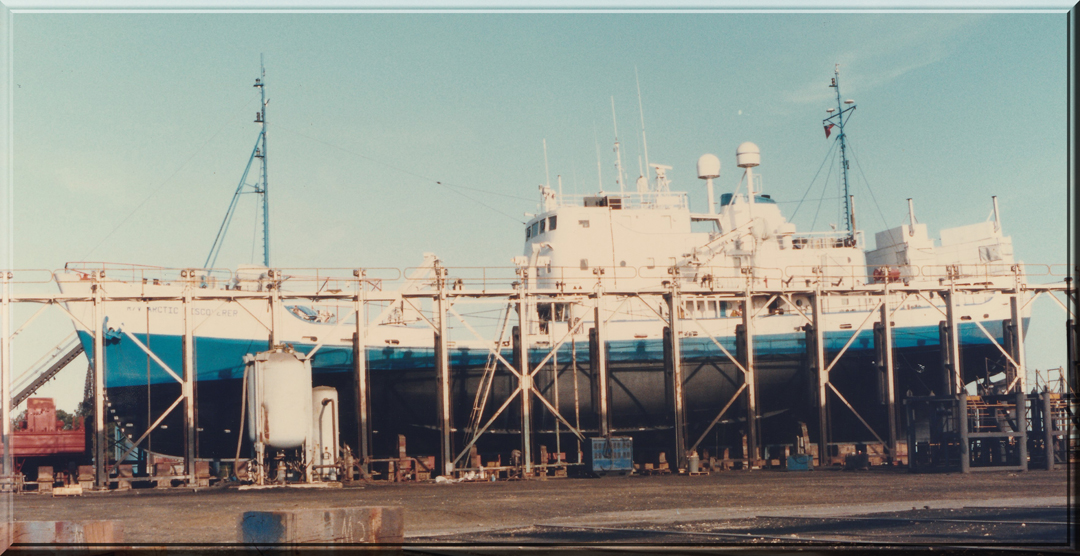 |
The ship was put in dry dock and the hull was gone over. Any needed repairs were made and new paint applied. Then began the process of adding new technology. A crane was added to raise and lower the robot, NEMO in and out of the ocean. New radar systems, video equipment, multiple generators and more. |
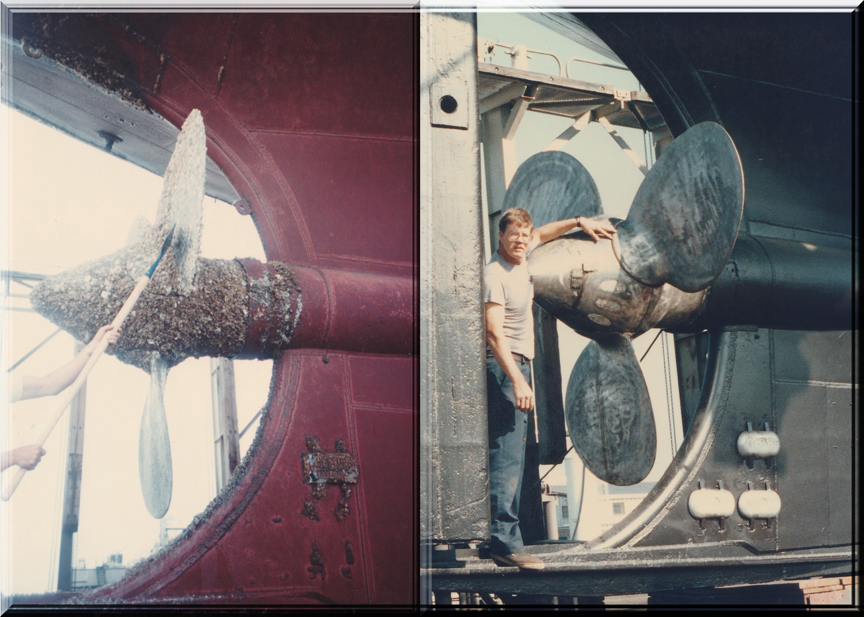 |
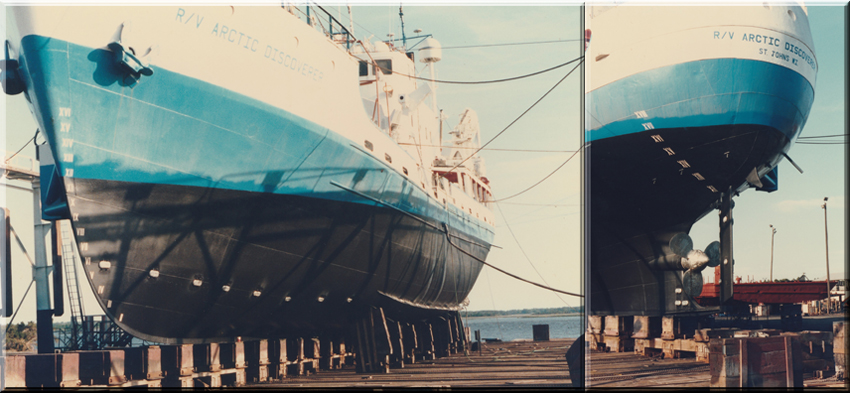 |
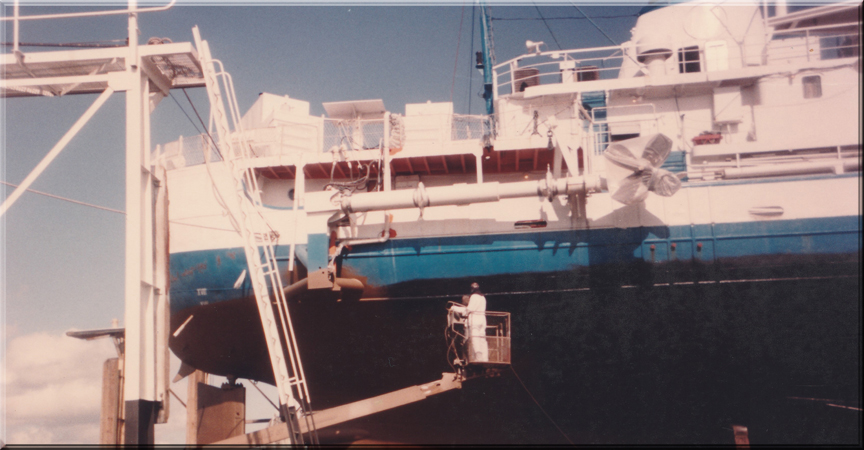 |
The group needed a ship that would handle their vast array of scientific equipment and their 12,000 pound robot, NEMO. The newly renovated R/V Arctic Discoverer was perfect for the job. Over several months, they had transformed the weary, weather worn ship into a high tech, cutting edge deep ocean research and recovery vessel. At the time, the Arctic Discoverer was one of a handful of ships in the world that was equipped with a GPS positioning system.
This GPS system operated a large thruster prop placed on the side of the ship. GPS coordinates sent to a satellite would run through a computer on board the ship giving the thruster commands, the thruster would make slight adjustments to keep the ship within 18 feet of their desired position over the wreck site, even in bad weather and high seas.
Right: Thruster and Prop for the GPS positioning system. Photo Credit: Americas Lost Treasure; Thompson, 1998 |
|
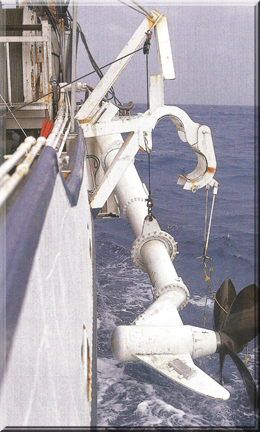 |
NEMO, the 12,000 pound ROV.
Photo Credit: Americas Lost Treasure; Thompson, 1998 |
|
It was September 11th, 1988 when they discovered the wreck of the S.S. Central America. After retrieving the ship's bell, they filed claim to the salvage rights and began plans for the recovery of the California Gold and numerous artifacts that sank with the ship in 1857. Located 160 miles off the Carolina coast, the wreck sat at approximately 7,200 feet deep.
Left: The Arctic Discoverer heading out to sea.
Photo Credit: Americas Lost Treasure; Thompson, 1998 |
|
Once the S.S. Central America was discovered, Thompson announced to the world that they had located the wreck. From 1988 to 1991, they recovered a little over two tons of gold coins, gold bars and numerous artifacts from the wreck site.
Breakdown of gold and silver aboard the S.S. Central America:
Army Shipment: 15 tons of gold, including 600 - 50 pound gold bars. (This has not been verified, and is in question.)
Commercial Shipment: Approximately 61,000 Troy ounces of gold, or a little over two tons. Value in 1857 was $1,219,789.
Passenger Gold: The newspapers in 1857 reported that the passengers aboard the ship likely carried an amount of gold equal to, plus or minus, the commercial shipment. They had a great digging season prior to the trip.
A conservative estimate of the gold on the ship at the time of the sinking would be between 2.5 to 3 tons of gold. Perhaps up to 3.5 tons. This estimate does not include the Army shipment which, to date, no evidence of it being on the ship has been found.
A businessman named Pasqual Esquerra from Chile boarded the ship in Panama with a trunk, or bags, containing approximately 3,000 silver 50 centavo and 1 peso coins. Many of these were recovered.
Lawyers and Lawsuits
Of course, there is never a happy ending. There were lawsuits filed by insurance companies that had paid out claims in 1857. Over the next couple of years, the Arctic Discoverer spent many months at sea working the wreck site while court battles continued back on the mainland. In 1991, recovery operations were suspended at the wreck site.
After almost ten years in court, the Columbus America Discovery Group was awarded 92.2% of the recovered treasure in 1998. Unfortunately this came at a cost of millions in legal fees, investors waiting to recover their investment, the crew waiting for their money, one problem after another finally took its toll. The investors would not give anymore money, and now new court battles were being waged, against Tommy Thompson. |
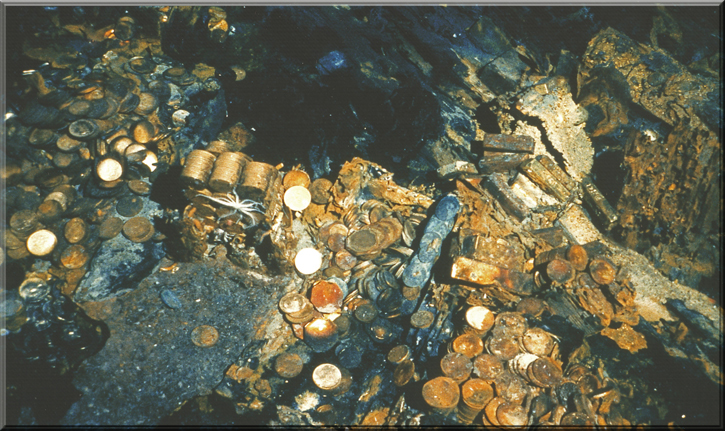 |
Piles of gold coins and bars sitting on the ocean floor. |
In May of 2013, the US Federal Marshals auctioned off the R/V Arctic Discoverer to a local salvage company. The ship had been sitting quietly at a dock in Green Cove Springs, Florida for several years. Her fate was sealed, the most famous treasure hunting ship in US history was now headed to the scrap yard!
For all the bad that happened, a lot of good came from this adventure. Because of the ideas and dreams of Tommy Thompson, Bob Evans and the historic crew of this ship, history was made. They had successfully located and recovered the most famous shipwreck in American history. They conducted the first deep ocean recovery of a shipwreck using the Arctic Discoverer and the ROV NEMO to do the work. The recovery of the S.S. Central America was considered "The Greatest Treasure Ever Found" according to Life Magazine. Christies Auction said that the gold from the Central America was considered to be "America's Crown Jewels". |
This was not just a treasure hunt. Thompson and his crew did not go down and scoop up all the gold and dump it on the deck to get rich. They preserved the history of the wreck site by meticulously removing each piece of gold and artifacts very carefully to preserve them. They also discovered several new species of deep ocean life forms never seen before, including a new species of large octopus. Some of these new species were later used in cancer research. They recorded the first ever sighting of a 21 foot Greenland shark at over 7,000 feet, before that, no one knew they lived at such depths. The promise of gold attracted the investors to finance the trip, but Thompson's vision was not getting rich as a treasure hunter, he wanted to prove that deep ocean recovery was possible, and he did that. The story of the S.S. Central America, the R/V Arctic Discoverer and Tommy Thompson and his team has been documented by the History Channel on their 'History's Mysteries' show 'Ship of Gold'. It is also documented in the books 'America's Lost Treasure' by Tommy Thompson and 'Ship of Gold in the Deep Blue Sea' by Gary Kindler.
It is estimated that perhaps another ton of passenger gold still sits on the wreck site, waiting for the next adventurous person to come along and find it. If I had the resources, I would already be there!
R/V Arctic Discoverer, during her glory days at sea.
Photo Credit: Ohio Journal of Science, March 1995 |
|
|